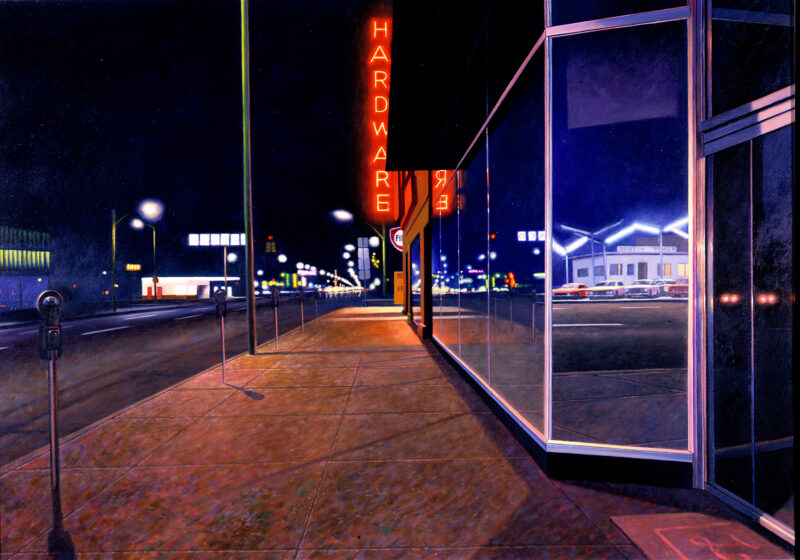
Denver Nights II
Forsman, Chuck
1975
Artwork Information
-
Title:
Denver Nights II
-
Artist:
Forsman, Chuck
-
Artist Bio:
American, born 1944
-
Date:
1975
-
Medium:
Oil on Masonite
-
Dimensions:
24 x 33 3/4 inches
-
Credit Line:
Wichita Art Museum, Museum purchase, Director's Discretionary Fund
-
Object Number:
1979.33
-
Display:
Not Currently on Display
About the Artwork
A long and straight city street with neatly paved sidewalks lined with storefronts, streetlights and parking meters, diagonally sweeps into the distance in this 1975 composition titled Denver Nights II by the American realist Chuck Forsman.
This composition is exciting by virtue of the intensity of realism in the rendering of such features as the high-powered electric streetlights, the neon signs, the automobiles, the chrome-framed window panels and the texture of the sidewalks. It is also fascinating in that it is filled with intriguing puzzles, which compel careful and close viewing if we are to disentangle the compositional ambiguities and more fully understand the content and aesthetic significance.
Structurally, the work is divided into three vertical segments. One consists of the right edge with the angled narrow glass panel from which a street behind us with a motor sales lot and a display of lined-up autos is reflected. A second segment is the stretch of glass windows along the sidewalk, reflecting the opposite side of the street at the left. The third is the left side of the street itself. It is the interplay between these three sections that supplies the ambiguities and captures our interest. Moreover, as we view the painting, we are allowed to see what is in front of us as well as what is behind us and we are, therefore, thrust into the world of the painting and brought into direct contact with the realism of the setting itself.
But the real excitement derived from this painting is the vivid illusion of reality which Forsman furnishes us, for he has treated each component with meticulous care and objective precision—so much so that our vision is intensified and we are made to see many features of the scene that would normally remain unnoticed by our subjectively selective eye. Indeed, through the artist’s interest in his subject, those features are not ignored but instead become deeply etched into our consciousness. In actuality then the illusion of reality found here as in many works of the new generation of realists, rivals the reality itself and we may certainly conclude that the image presented is in one sense more real than the reality itself. It is in that respect that the new realism differs significantly from the realism of the past, and that although the influence of the camera and of color film is evident, a work such as this can never be mistaken for a photograph.
But there is another aspect of this painting which must be considered. It is interesting that the composition itself seems as objectively impersonal as the technique is objectively precise. No part is more important than any other part. The streets are clean; there is no debris. The typically standardized icons of 20th century urban life are much in evidence but no human beings are shown and we, the unseen viewers, are the only participants. Indeed, a numb stillness pervades the setting as though time had come to a halt evoking a lonely and eerie mood that is much intensified by the surface reflections and the soft hazy glow of light against the deep blue cloudless night sky.
It is always tempting to read meaning into a work of art even though such meaning may never have been intended. But art always interprets life, and it would appear certain that this work is a profound comment on the American consciousness, and perhaps on the question of how the individual fits into the total scheme of a mechanized lifestyle, which openly glorifies banality. Whatever the meaning, we can be reasonably confident that the statement is the product of a keenly sensitive and probing mind that is pointing up issues, the significance of which we are perhaps not able or yet ready to fully accept.